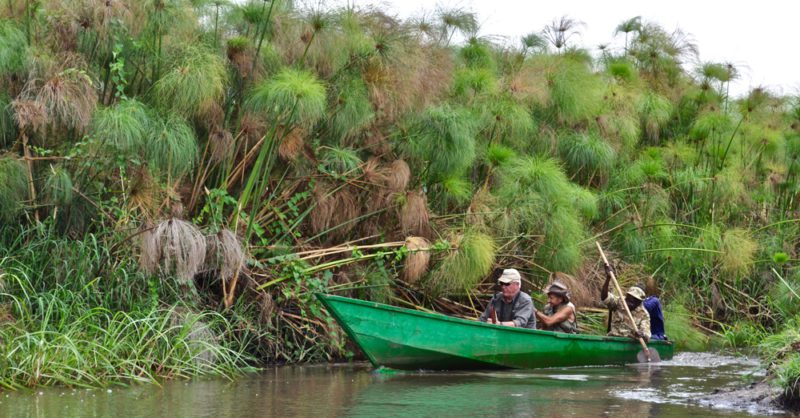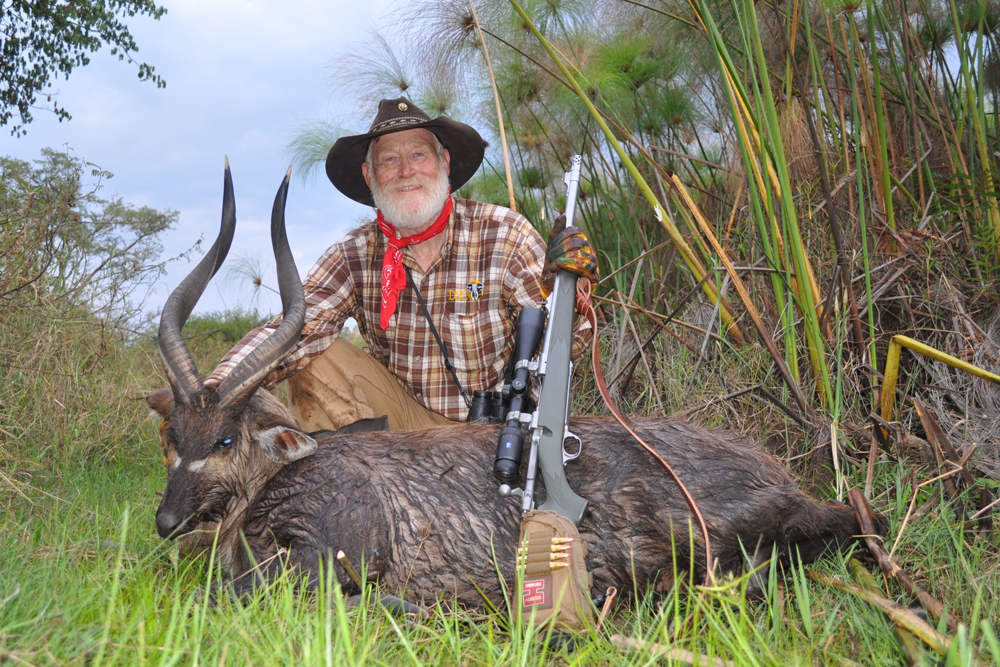“Do not dip your hand into the water. Crocs and pythons! No need to tempt them. In the Mayanja River papyrus, they grow to twenty feet and longer.”
The warning came from my PH, Christian Weth, head of Uganda Wildlife Safaris, as trackers paddled our noticeably unstable canoe along the narrow water trail traversing 12-foot-tall papyrus. Christian was seated in the front of the canoe, a fact he explained in his next breath.
“We are on a hippo trail. Confronted by an enraged bull, I will assess and remedy the situation.” This as a 12-foot crocodile slithered into our watery trail a boat paddle’s length ahead of us and disappeared around the bend.
Hungry crocs, territorial hippos, pythons, and who knows what else lived under the floating papyrus. What had I gotten myself into?
“We recently saw an impressive sitatunga ram just around the bend where the locals chopped papyrus to create fresh growth,” Christian said. “Sitatunga love to feed there.”

Tim Fallon and his PH searching for a sitatunga ram on Uganda’s Mayanja River. (Photo: Larry Weishuhn Outdoors)
Yes, that was why Tim Fallon with S.A.A.M (Sportsman All-Weather, All-Terrain Marksmanship) and I had journeyed to Uganda—sitatunga, the uniquely handsome, swamp-dwelling, spiral-horned antelope with elongated hoofs. Our game plan called for Tim and his PH, Dougy Stephenson, to go in one canoe while Christian and I went in another, floating different trails that joined five miles from camp. Hunting as we went, we also planned to glass from machans (hunting blinds) strategically placed along the routes.
At the third machan Christian and I crawled in to, we spotted a sitatunga female, but no more. Tim, we learned later, had also only seen an immature ram.
On our way to camp, we spotted a long-horned Nile bushbuck, one of two handsome bushbuck subspecies in the area. An “interesting stalk,” and Tim finally got his shot.

Tim Fallon shows off his Nile bushbuck, taken on the way back to camp. (Photo: Larry Weishuhn Outdoors)
It was decided at camp that afternoon that Christian and I would hunt a machan overlooking two manipulated papyrus “food plots” the next day while Tim and Dougy would hunt another area downriver. Our machan reminded me of treestands I had built as a youngster for whitetail hunting. Christian had hardly gotten halfway up the ladder when he stopped to glass, then frantically waved me up.
On the platform, I saw why he was excited: A sitatunga ram was feeding near the edge of the northern opening in the papyrus.
“Mature ram, twenty-six or so inches in length.” He added, “Weather forecast calls for heavy rain and strong winds for the next five days.”
Before Christian could say more or I could get my .375 Ruger Guide Rifle on the ram, it walked into the tall papyrus and was gone.
We hoped the ram we had just seen or another like it would step into the lush, freshly cut papyrus opening. A half-hour later, a sitatunga ram did just that. After a quick look, I dropped my binoculars.
“Same ram. I’m going to take him.”

Machans offer a bird’s-eye view of the papyrus below. (Photo: Larry Weishuhn Outdoors)
I bolted in a 300-grain Hornady DGX round, got a solid rest and crosshairs on the sitatunga, then waited for a broadside shot. He turned, but only a few steps before he would again disappear into the tall, dense vegetation. The ram hesitated, I pulled the trigger, saw him react as if mortally hit, and immediately bolted in a fresh round. I shot him a second time as he dove into the papyrus.
“We will give him a few minutes then go retrieve him.” Christian then added, “You cannot go with us; you are too big. The floating papyrus will not support you.”
I dearly wanted to go, but I also did not want to fall through. Thankfully, I didn’t have to wait long to learn the results. Only ten minutes after Christian and the trackers crawled down and walked onto the papyrus, I heard words I had longed so many years to hear.
“Sitatunga down!”

